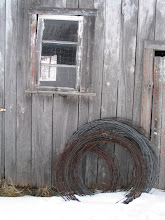The problem with the tiles: not one has a smooth surface. Some are off by a quarter to a half inch over their length. Some are convex, some are concave, all have some type of imperfection that makes them hard to place. And this is Grade A slate:

As Eric put each tile into place and shimmed them into submission, I gauged the thickness of the edge, put on my spare biceps and pulled out what I thought to be the corresponding tile from the pallet shown above. They weigh about 4o to 50 pounds each and are a bit cumbersome and hard to move and place. We then placed my best choice down, flipping it end to end and over to find its best fit. Then we lifted the tile, and smoothed or added screening as necessary. Repeat about 10 times per tile, and we're satisfied.
 We used a spackling knife, a piece of wood and our "motivator", commonly known as a hammer. (Actually, it is a carver's mallet we purchased at Lee Valley, and it is one of our favorite tools.) Eric also needed to ensure that 1) his first tile was straight, and 2) the level was correct. All of this was what the Québecois colloquially refer to as "gossage", a nice all-around word that means fiddly, nit-picking, detail-oriented work.
We used a spackling knife, a piece of wood and our "motivator", commonly known as a hammer. (Actually, it is a carver's mallet we purchased at Lee Valley, and it is one of our favorite tools.) Eric also needed to ensure that 1) his first tile was straight, and 2) the level was correct. All of this was what the Québecois colloquially refer to as "gossage", a nice all-around word that means fiddly, nit-picking, detail-oriented work.
Both of us have so much mud on the soles of our shoes, every time Eric asks me to go in the house, I cringe because I hate removing my workboots but with our mud-caked boots we don't really have the choice. I sound like a drill seargent before we work out side: measuring tape, check, level, check, Olfa knife, check...anything to avoid me from having to remove my shoes 10 times before we're organized.
At the end of the day, we managed to put down 21 tiles, or 42 square feet. By the time we had found our rythym we were getting tired, so let's hope that tomorrow we have a bit more "oomph" and can get even more done.
Once again, we were rewarded with a fabulous sunset:
 Somehow, it sort of makes all the hard work worthwhile.
Somehow, it sort of makes all the hard work worthwhile.I almost hesitate to post the photo below since it doesn't really do any justice, but there it is anyway. The crappy steps that lead down to the slate will be done in slate too, but they will only be delivered next spring. We will have 3 steps, 16" wide and 96" long leading down to this path, and we haven't really figured out the full details, so stay tuned. When I said we were making this all up as we go along, I wasn't joking.
 All told, we are happy with the result. It's nice when a project lives up to your expectations.
All told, we are happy with the result. It's nice when a project lives up to your expectations.

















